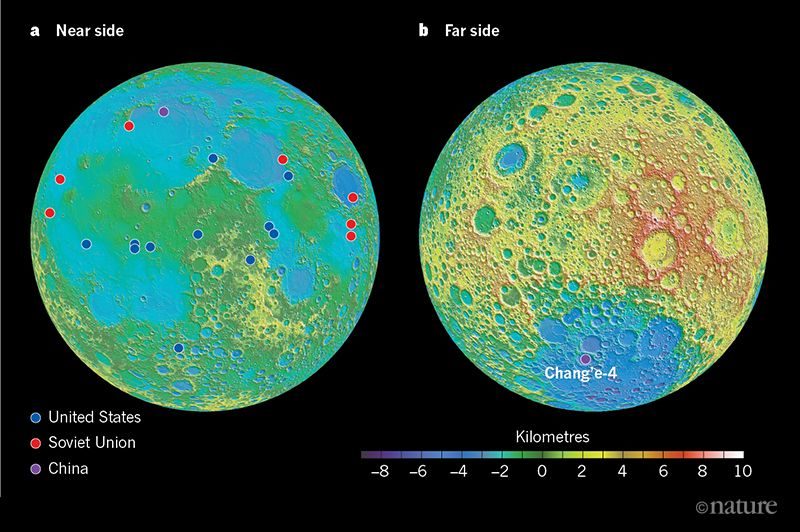
Similar to the other inner bodies of the Solar System, the Moon is thought to have gone through a magma-ocean phase, in which it was partially or completely molten2,3. As the magma ocean solidified, dense mafic (rich in magnesium and iron) minerals such as olivine and low-calcium pyroxene crystallized at the ocean's base. After three-quarters of the ocean had solidified, less dense minerals such as plagioclase (aluminium silicate) floated to the surface, which led to the formation of a highland crust composed mainly of calcium-rich plagioclase. And at the end of the ocean's solidification, minerals enriched in elements that were the last to enter the solid phase crystallized beneath the crust. This process therefore induced radial stratification - a series of compositionally distinct layers - in the lunar interior.
Despite regional variations in the Moon's crust4, the observed composition and mineralogy of distinct surface regions called lunar terranes - as revealed by sensors on orbiting satellites and by samples returned to Earth - are consistent with this conceptually simple model of formation. However, the characteristics of the lunar mantle, especially in terms of its composition, structure and stratification, remain uncertain and poorly documented. Astonishingly, NASA's Apollo spacecraft and the Soviet Union's Luna probes, all of which landed on the near side of the Moon (Fig. 1a), did not return samples of the lunar mantle5.
With the successful implementation of its Queqiao communications satellite, in May 2018, the Chinese Lunar Exploration Program has paved the way for in situ surface exploration and sample-return missions on the lunar far side. The oldest and largest structure on the Moon - the roughly 2,500-kilometre-diameter South Pole-Aitken Basin - is located on the planetary body's far side. This structure's size and regional crustal thickness (as estimated by NASA's GRAIL mission6) suggest that it might have been produced by an impact event that penetrated the Moon's crust and interior, excavating lunar-mantle material and distributing it on the Moon's surface. Consequently, in situ exploration of the South Pole-Aitken Basin has long been advocated by scientists internationally.
Li and colleagues describe results obtained by Chang'e-4, which touched down in the 186-km-diameter Von Kármán Crater on the floor of the South Pole-Aitken Basin (Fig. 1b). Their findings are based on the spectra of reflected light that were recorded by Yutu2 as it traversed the Von Kármán Crater. The authors report the detection of materials in the vicinity of the Chang'e-4 landing site that differ markedly from most samples obtained from the Moon's surface. In particular, the materials contain mafic components that seem to be dominated by a mixture of olivine and low-calcium pyroxene.
The authors suggest that these components represent deep-seated materials, potentially from the lunar mantle, that were excavated when the South Pole-Aitken Basin formed and then, possibly, redistributed as ejecta from the impact event associated with the creation of the nearby 72-km-diameter Finsen Crater. On the basis of these observations, the Moon's upper mantle might be composed predominantly of both olivine and low-calcium pyroxene.
The methods and tools that Li et al. used for the spectroscopic analyses were handled with great care, and the authors' detection of the minerals is highly reliable. But the precise determination of the relative mineral abundances in the mineral assemblages - which might include small amounts of plagioclase and high-calcium pyroxene - is a contentious issue, because of the complex nature of the minerals' overlapping spectral features. Further modelling efforts will certainly be required, with a focus on the size distribution of mineral grains, to attain a well-constrained assessment of the olivine composition7.
In future work, Li et al. should characterize at the landing site not only soil samples but also samples of rock. This task could be carried out through a comprehensive in situ exploration of the area that surrounds the Chang'e-4 landing site, with the acquisition of reflectance spectra from selected bedrock targets. Such exploration is also crucial to better document the geological context of the detected materials, so that potential issues that might call into question the authors' interpretation of their results can be addressed. These issues include the possibility that the impact that created the South Pole-Aitken Basin led to the formation of a massive sheet of melted rock that is tens of kilometres thick and has compositionally distinct layers8,9. Another complexity could arise from the regional emplacement, after the formation of the South Pole-Aitken Basin, of cryptomaria10 (lava flows buried by subsequent crater ejecta).
Nevertheless, Li and colleagues' results are thrilling and could have considerable implications for characterizing the composition of the Moon's upper mantle11-13, and for establishing constraints on characteristics of the lunar magma ocean that would have varied with time. Such characteristics include the ocean's depth, its rate of cooling and its rate of evolution - the latter of which is controlled by magma viscosity, convection processes and the subsequent development of instability. In a broader sense, the authors' findings might also affect our understanding of the formation and evolution of planetary interiors. It is of the utmost importance to make progress towards unpacking the geology of the lunar far side, expanding our fundamental knowledge of the Moon's formation and the origin of the crustal asymmetry that exists between its near and far sides14, and preparing future sample-return missions.
Nature 569, 338-339 (2019)



Craters are thought to be the result of meteorite and asteroid impacts, meaning there should be a certain proportion between their depth and width. Instead many wider craters have similar depths to significantly narrower craters, with some even appearing convex. And when astronauts attempted to drill into the craters, they were barely able to penetrate the surface, discovering processed metals like brass, mica, and pure titanium.
Etc etc etc